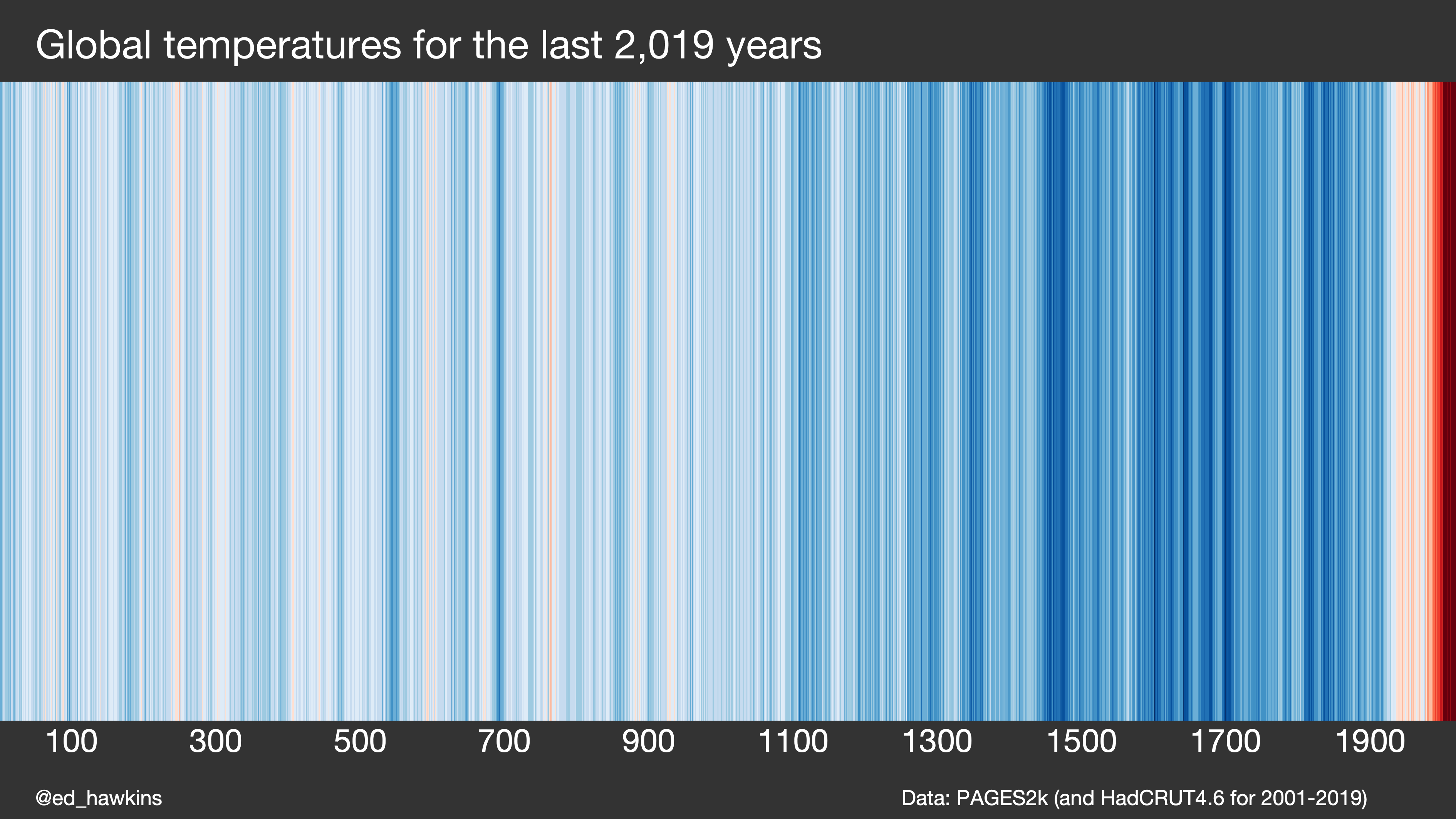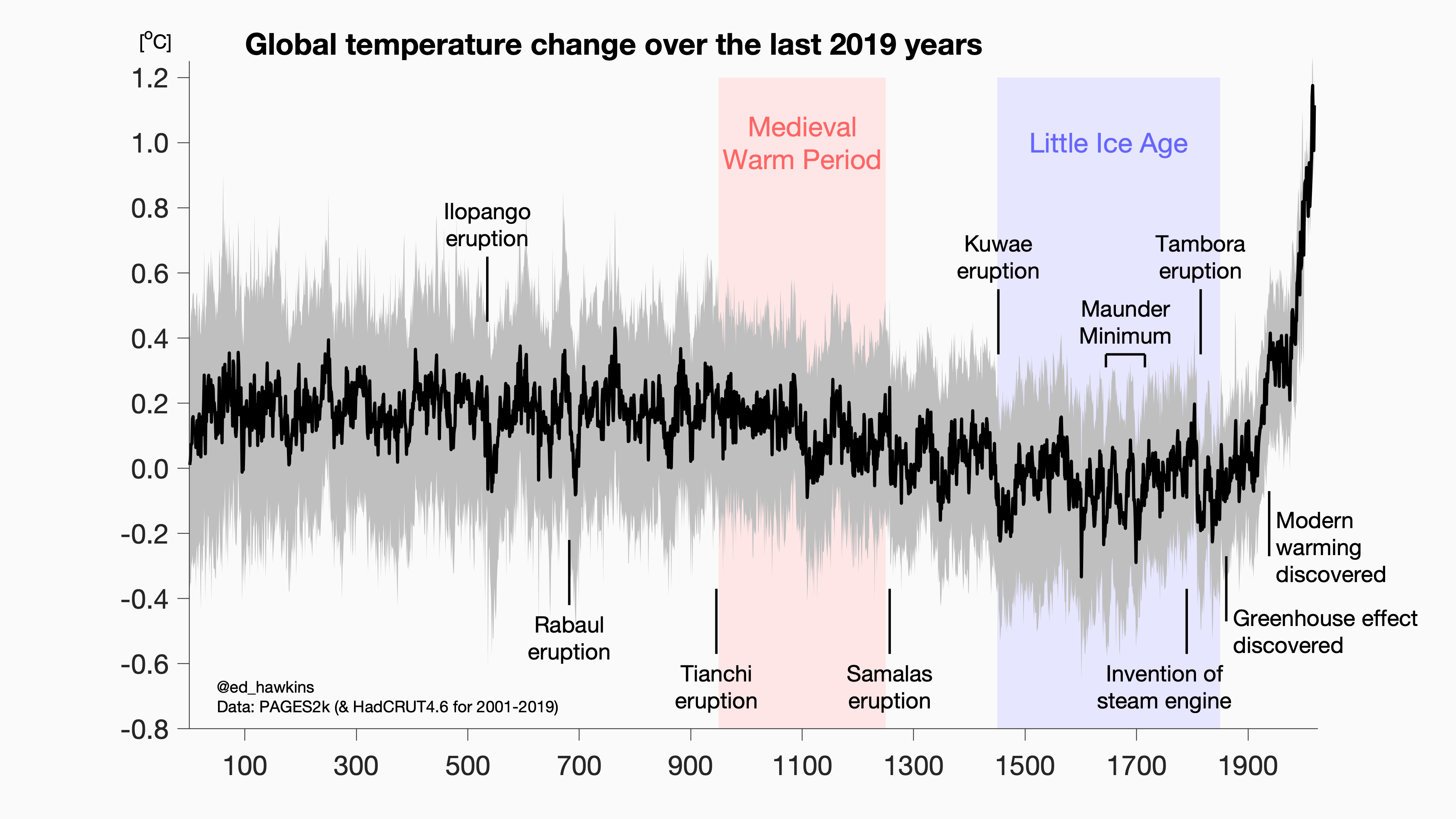The most common comment on the ‘Warming Stripes’ visualisations is: ‘what happened before 1850’?
I’m glad you asked.
We have a new reconstruction of global temperature going back to the year 1AD thanks to the work of the PAGES2k team. This reconstruction includes data from a wide variety of proxy records such as tree rings, cave deposits, corals, etc.
The warming over the past 50 years is stark compared to the variations that have occurred naturally over the last 2000 years. It is not normal.
The PAGES2k reconstruction also comes with uncertainty estimates, and so can be visualised in a more standard way, with key relevant global events added, such as large volcanic eruptions, the Maunder solar minimum and historical dates of scientific discoveries.
The data show that the modern period is very different to what occurred in the past. The often quoted Medieval Warm Period and Little Ice Age are real phenomena, but small compared to the recent changes. In this example, the reference period is 1850-1900, which is often used as an approximate ‘pre-industrial’ level.
The invention of the efficient steam engine in 1790 by James Watt kick-started the industrial revolution and our reliance on burning fossil fuels for energy. This has brought many benefits to humankind, but we are now experiencing the side effects of that development.
Data: PAGES2k


Excellentissim, Ed ! My infinite thanks !
Hello,
Why is WMP not visible on this graph? We show this period but if we had to guess it, nobody would see anything on this graph. Is it because it is a global reconstruction and the WMP is a non-global phenomenon ?
Yes, this is a global reconstruction which shows a very weak warm period. It would have looked relatively warmer in the 1960s, when the period was named, and because the data further back didn’t exist.
The medieval warm period was a North Atlantic phenomenom.
Great figure! Maybe it complicates the figure too much, but I wonder if it’s worth putting in some marker for the role of aerosol pollution in the mid-twentieth century.
I did try and find space to label the clean air acts but it was cramming too much in!
RE: Craming too much in
Actually this is an excellent chart — a suggestion cries out for a follow up graph with the x-access starting around 1900…. up to 2020.
Brilliant graphics! I work for a large/global commodities trading firm and I greatly appreciate these novel visualisations which I use to convey climate information to my colleagues. Keep up this important work!
What is the temporal resolution?
The data is available and plotted annually.
That was not the question. 🙂
The last century has been warmer than the MWP?
This is quite a reversal. When did this happen?
Great work! But the y-axis on the timeseries of your PAGES plot should include a “Δ”. It is “Δ °C” and not just “°C”
Please can I request to label the end year on the X axis on both of these graphs, so they are still valid in a few years’ time. Or add to titles 1 AD – 2019 AD.
Hi Ed/Guy,
Is there anything similar available that covers the last 10,000 years or so?
Or is Marcott et al. (2013) still the place to go for that sort of thing?
There are a couple of different sources for the last 20ka, including Marcott. Will think about that next!
Excellent news!
Please let me know as soon as that task is complete.
TIA
Is there any indication that the climate was impacted by the death of the Aztec and Mayan civilizations and the recovery of the environment after those and other American civilizations disappeared?
Dear Ed,
thanks a lot for the vis (and the cool talk at data stories podcast). 🙂
I wanted to suggest if it wouldn’t be helpful to put the stripe vis into a white frame rather than a dark one.
The thing is that the darkest red stripes then tend to blend with the dark-gray frame and thus seem as a part of the frame rather than displaying high values. Therefore I believe surrounding it with white would help the readability.
Also, I would like to ask if it be okay with you to add the white frame to it and publish it at our twitter @faktaoklimatu (referencing you of course). In short, we try to communicate data about climate (change) in a comprehensive (and often visual) way in Czech language.
You are very welcome to adapt and share the graphics!
Could do with a small cool metal badge. 2 inches is too big for general wear though I can see the need to say it loud. Maybe it’s not tecnically possible. Nice idea tho.
Absolutely fantastic work!! Would anything convince the GSM and denier crowd? Probably, not; they are too invested in their fantasies. Maybe, the JP Morgan/Chase leaked warnings to it’s clients might have an effect, letting them then examine excellent visuals, like this, to begin to see sooo clearly, that Western Civilization is in trouble.
It is clear to me, that a warming period, at least as bad as the PETM, is on the near horizon. The few human beings, that have any chance to survive through it, will be no doubt eyeing the Southern Hemisphere, including the future tropical islands of Antarctica.
I tried to post this earlier but seems it’s not here, pls. excuse me if I end up posting the same thing twice.
I commend the work that climate and other scientists around the world are doing to obviate what we are doing to our world!
However.
Many yrs. ago (was it 25?) I saw a graph of the Vostok (spelling?) Ice core sample analysis, and also the NASA photographs of the depleting Nth. Arctic Circle ice sheet coverage in consecutive summer/winter seasons since 1990.
It clearly showed that since approx. 1900 we have constantly increased CO2% in the atmosphere resulting in increasing temps. Compared to the scope of changes over the last 1.5mill. yrs. our climactic change is OFF the charts! Even a lame brain, non scientist like me could see this 25yrs. ago.
I love that our youth is taking time off school to put pressure on our politicians, but alas they shut their ears because they are beholden to the mining and fossil fuel industries.
What I think needs to happen to FORCE change, I believe this is ONLY what will make a change, is that the ppl. backed by the scientists mount class action lawsuits against corporations and political parties that obstruct and resist the obviously necessary transition to the ‘next generation’ of energy and transport technologies.
WE will have to FORCE a move to the next ‘AGE’.
Hi prof. Ed Hawkins
Brief inquiry:
I inquire about how reliable ice drilling samples are when drilled from high pressure ice depths. Does the content of air bubbles change when they are raised to a lower pressure on the ground?